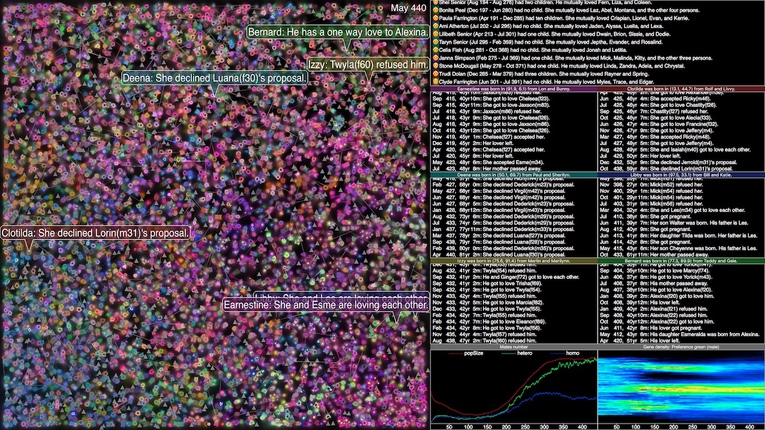21st Art Division Excellence Award
Rapid biography in a society of evolutionary lovers
Media installation
UNEMI Tatsuo / Daniel BISIG [Japan / Switzerland]
Outline
In this installation, we watch as an evo- lutionary ecosystem simulator, which imitates a human society, automatically generates rapidly-unfolding life dramas. Thousands of individuals exist in a virtual space within the simulator. Men are an- gular, women are rounded, and children are smaller versions of those gender forms. “Objects” are represented as tri- angles. The progression of time is shown in steps, and one step represents 10 days. Lifetimes each last about 1.5 min- utes, going through the cycles of birth, falling in love, separation, and death. Individuals try to woo those who have genes with appearances they desire re- gardless of gender, but because babies can only be born between opposite-sex couples, the individuals evolve to take on appearances that will attract the roman- tic interest of members of the opposite sex. There are those who fall in love with members of the same gender, and some even who fall for “objects.” The viewer can see the individuals moving around and sentences describing events in the lives of some of the sample individuals. The sentences are simultaneously read aloud by a speech synthesizer, which can be heard through the speaker along with sounds of a babies being born, voices of men and women professing their love, and funeral bells. The inorgan- ic, logical simulation gives an objective look at the cycles of life we all lead.
Reason for Award
There are those who attempt to ex- plain the origins of beauty through the theory of evolution and this, of course, should be verifiable through computerized simulations of ecosys- tems and societies. This installation work’s greatest significance comes from having done research into that very issue. However, sex, birth, and death are compelling life events which, under the theory of evolution, are discussed as genetic exchange, replication, and selection. If this piece were considered to have gone be- yond the said significance, it would be due to this point. We are stunned by the fact that the clamorous hu- man voices overlapping with sounds of funeral bells are emitted from only a very small sample of up to 8,000 life stories being generated within the span of a minute. The texts that instantaneously appear and disap- pear are just as the title says -rapid biographies- and they are epitaphs. And the mechanism that does things like assign individual names and give accounts of separations lets us view this work not as just a simulation or media art, but as a new type of re- alistic literature or criticism of exist- ing literature backed by a sample of enormous quantity. I find this to be immensely moving.(NAKAZAWA Hideki)



